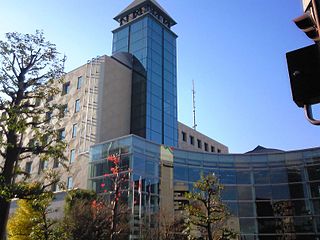
Higashikurume is a city located in the western portion of the Tokyo Metropolis, Japan. As of 1 April 2021, the city had an estimated population of 117,020, and a population density of 9100 persons per km². The total area of the city was 12.88 square kilometres (4.97 sq mi).

The Chikugo River flows through Kumamoto, Ōita, Fukuoka and Saga prefectures in Japan. With a total length of 143 kilometres (89 mi), it is the longest river on Kyūshū. It flows from Mount Aso and empties into the Ariake Sea. It is also nicknamed "Tsukushi Jirō".
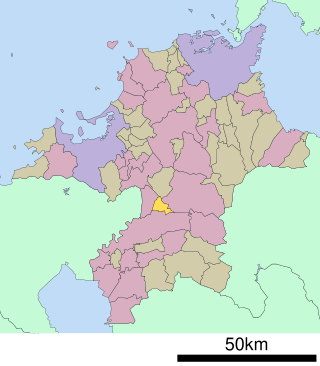
Mii is a district located in Fukuoka Prefecture, Japan.
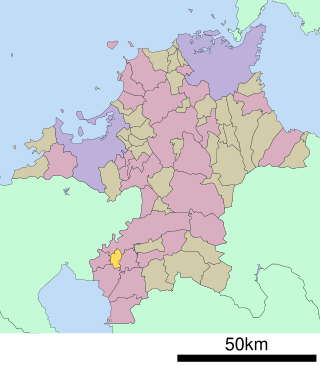
Mizuma is a district located in Fukuoka Prefecture, Japan.
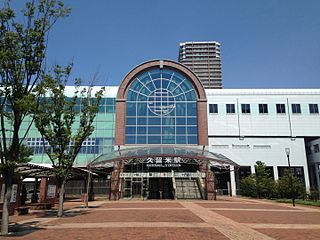
Kurume Station is a junction passenger railway station located in the city of Kurume, Fukuoka, Japan. It is operated by the Kyushu Railway Company.

Kurume University, abbreviated to Kyudai, is a private university located in Fukuoka, Japan, on the island of Kyushu.
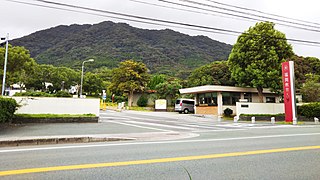
University of Teacher Education Fukuoka (UTEF) is a national university in Munakata, Fukuoka, Japan. The predecessor of the school was founded in 1876, and it was chartered as a university in 1949. The present name was adopted in 1966.
Kurume Institute of Technology is a private university in Kurume, Fukuoka, Japan, established in 1976.

Higashi-Kurume Station is a passenger railway station in located in the city of Higashikurume, Tokyo, Japan, operated by the private railway operator Seibu Railway.

Kurume Shin-Ai Women's College is a private women's junior college in Kurume, Fukuoka, Japan, established in 1968. In 2004 the college was selected for Good Practice, a fund program by the ministry of education.

Kurume-Kōkōmae Station is a passenger railway station located in the city of Kurume, Fukuoka Prefecture, Japan. It is operated by JR Kyushu. The station name refers to the nearby Kurume High School.

Nishitetsu Kurume Station is a passenger railway station located in the city of Kurume, Fukuoka, Japan. It is operated by the private transportation company Nishi-Nippon Railroad (NNR), and has station number T27. The Nishitetsu Kurume bus terminal is on the first floor.
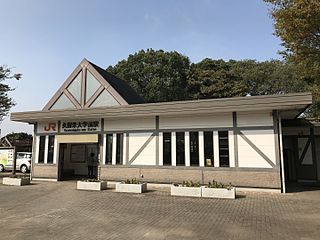
Kurume-Daigakumae Station iis a passenger railway station located in the city of Kurume, Fukuoka Prefecture, Japan. It is operated by JR Kyushu. The name means, literally, "in front of Kurume University".
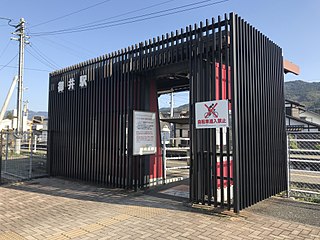
Mii Station is a passenger railway station located in the city of Kurume, Fukuoka Prefecture, Japan. It is operated by JR Kyushu.

Zendōji Station is a passenger railway station located in the city of Kurume, Fukuoka Prefecture, Japan. It is operated by JR Kyushu.

Chikugo-Kusano Station is a passenger railway station located in the city of Kurume, Fukuoka Prefecture, Japan. It is operated by JR Kyushu.

Bairin-ji (梅林寺) is a Rinzai temple in Kurume, Fukuoka Prefecture, Japan. Its honorary sangō prefix is Kōnanzan (江南山). It is known as a representative training dojo temple of the Myōshin-ji school.
Naritasan Kurume Bunin (成田山久留米分院) or Kurume Narita-san (久留米成田山) is a Shingon Buddhist temple in Kurume, Fukuoka Prefecture, Japan. It is a direct branch of Narita-san Shinshō-ji in Narita, Chiba Prefecture.

Kurume Castle was a castle structure in Kurume, Japan. Kurume Castle was built by the ninth son of Mōri Motonari, Kobayakawa Hidekane in 1587.

Kurume City Art Museum opened as the successor to the Ishibashi Museum of Art in Kurume, Fukuoka Prefecture, Japan in 2016. It forms part of the Ishibashi Culture Center, which opened in 1956, alongside the studio of yōga painter Sakamoto Hanjirō, relocated from Yame in 1980, and Shōjirō Ishibashi Memorial Museum, dedicated to the founder of Bridgestone and donated to the city by the Ishibashi Foundation after renovation in 2016, on the sixtieth anniversary of the Ishibashi Culture Center's opening. The focus of the collection is the work of local artists, notably Kurume scions Aoki Shigeru and Sakamoto Hanjirō, as well as Kyūshū yōga more generally.




















